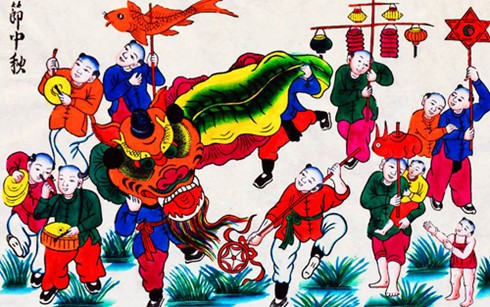(VOVworld) – Hang Trong folk paintings first appeared 400 years ago as religious and Lunar New Year hanging pictures. In the early 20th century, they covered more topics such as social practices and the illustrations of popular stories. Thanks to its open-mindedness, which met both religious and entertainment needs, Hang Trong folk paintings became much sought after.
Hang Trong folk paintings are named after a street in downtown Hanoi, where the artworks were sold during the Tet or Lunar New Year Festival. Pictures like the four seasons and the three men symbolize happiness, luck, and longevity were hung in the house as a wish of good luck and abundance. Worship pictures like the three-door temple gate, four-door temple gate, and ascending to the heaven were hung in pagodas and temples. Hang Trong paintings were indispensable on the altars of families in the worship of ancestors. Le Thi Mai, a resident of Hang Non Street, Hanoi, said:“My mother loves paintings and she hangs pictures of carps and peacocks on the altar of our house. The peacock represents women and family happiness while the carp represent men and a successful career. Carps who were able to pass through a magical gate with dangerous waterfalls will turn into powerful dragons.”
 |
| A Hang Trong picture depicts a traditional procession |
Artisan Le Dinh Nghien said: “Generations of my family have been engaged in painting. My older relatives said that in Hang Trong Street and adjacent areas, there were many households who worked at this style of paintings. After the wars, many abandoned this work but my family has still maintained it up to now.”
There are now only 30 woodblocks of Hang Trong paintings, the largest is 120cm by 80cm and the smallest is 45cm by 30cm. The printing process is followed by the strengthening of the back of the picture with 2 or 3 layers of paper pasted onto it. After the paper is dried, it needs coloring. It usually takes 3 or 4 days to finish a painting. Artisan Le Dinh Nghien said: “For the art of oriental painting, the process of strengthening the paper is very important. It decides the quality of a picture. The traditional Do paper is very thin, so we need to add 2 or 3 layers to make it easier to color. After a dozen years, a painting can be damaged, and I can help restore it to the original look.”
A beautiful picture reflects the skillful hands of artisans. Le Bich, a connoisseur of folk paintings, said: "Hang Trong paintings represent the essence of Hanoi city dwellers. Their techniques are sophisticated and not everybody can do it. The technique of draining colors is so difficult that even some professional painters fail. It looks simple but takes a dozen of years to master the technique. That’s why I like Hang Trong paintings so much.”
Hang Trong paintings are half-printed and half-drawn. After ink from the woodblocks is applied, the patterns are re-drawn and colored with feather brushes, crating a unique picture.